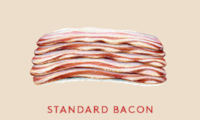What's Shakin' With Bacon

What's Shakin' With Bacon
According to the USDA, Americans consume 18 pounds of bacon per person per year.
The taste and smell are so powerful that even vegetarians are sometimes powerless in bacon’s midst.
But is it ok to eat? How much, and what kind? We've got answers to all your questions, straight ahead!
The Current Pickle
With so much love for the smoky strips, it’s easy to see how the internet freaked out when the World Health Organization lumped bacon in with tobacco as a group 1 carcinogen.
But the study reported you'd need to eat 6 slices of bacon every day to increase your risk of cancer by 18%.
Cancer aside, here are three health-related things to consider when eating bacon:
- Saturated Fat: An average slice of bacon has one gram of saturated fat. Not bad considering your daily limit is 15g, just beware common high-saturated-fat bacon pairings (we're looking at you, bacon cheeseburger 🍔👀).
- Sodium: One slice of bacon = 192 milligrams of sodium; three or four slices get you to about half your daily limit.
- Nitrites and Nitrates: These help extend the shelf life of processed meat like bacon, as well as enhance the flavor. As we discussed in our Hot Dog newsletter, these might increase your risk of heart disease (yes, even naturally occurring ones in "no nitrates added" meat products).
Researchers recommend making processed meats like bacon a “once in a while” food. Whatever that means to you, here are some tips for when you're ready to treat yo'self…
What's the Dillio with All the Bacon Labels?
Standard American bacon, known as “streaky bacon” in the UK, is made from the “belly” of the pig, which is not actually its stomach but the fat-streaked padding on the side of the animal. It's cured, then smoked, then sliced.
Canadian bacon, probably most famous in the U.S. as the meat in eggs Benedict, is made from the lean loin on the back of the pig, which is why it's known in Canada as "back bacon." It's cured, smoked and fully cooked, and basically looks like thick slices of ham.
Let's take a closer look at American bacon, and the most common terms you’ll find in the market.
CUT
- Center-cut: Marketing hoo-ha. This is regular bacon with the fatty ends cut off. As in, shorter strips. As in, you’re paying the same (or higher) price for less bacon. In a Cook’s Illustrated test, the 12-oz center-cut packages were exactly the same price as the 16-oz regular packages from the same brand.
- Thick-cut (or extra thick): Gaining popularity and popping up on lunch and dinner menus, these taste smokier than regular strips.
CURE
- Wet-cured: Soaked in brine for several days to cure and get nice and salty-tasting. Can result in quality bacon, especially if the meat is subsequently naturally smoked, which can help dry out the meat while adding flavor. Nueske's and Wright make good ones. 👍
- Dry-cured: Bacon aficionados swear by these pork bellies that have been rubbed with a curing mixture before smoking and are never exposed to extra moisture. These tend to have a denser texture and a saltier flavor, and show relatively little shrinkage as they cook. Benton's and Tender Belly are great examples. 👌
- Brine-injected: If it doesn't say wet-cured or dry-cured, chances are it's brine-injected and will give you a one-dimensional flavor, uneven crisping, and a greasy kitchen. Look for ascorbate or sodium erythorbate on the ingredients label, and avoid, avoid, avoid. 🙅
HEALTHY (maybe)
- Organic bacon: Should be free of antibiotics and preservatives, and organic pigs should be fed organic feed. Organic bacon can still have added nitrates.
- Reduced sodium bacon: Has about half the sodium of regular bacon. A good option to have if you're watching your sodium.
- Turkey bacon: still high in saturated fat and sodium and doesn’t carry as many health benefits as many believe, and in fact experts warn it can be WORSE for you since it is perceived as harmless so you may be tempted to eat more of it.
ALL NATURAL
This term has nothing to do with how the pig is raised. Under the USDA definition, pork is "natural" as long as it has no artificial ingredients added after it's slaughtered and is "minimally processed," which is almost laughably vague.
Not sure about a company's practices? Google it. Ask on the company's Facebook page. Go to your local farmers' market and talk to the people who raised the pigs. They'll probably have super cute photos to show you, too.
The Hot Pickle
Ready to eat the good stuff?
We are loving Black Pig Meat Co.: the pigs are sustainably raised on family farms that respect the land and the animals in their care. the pigs are heritage breed, raised without antibiotics and hormones, and are allowed to roam free.
Black Pig Meat Co. Owners, Chefs Duskie Estes and John Stewart
Scott Gold, Extra Crispy’s in-house bacon critic, did a write-up of the “Best Bacon in America.”
His #1 pick: Vande Rose Farms Applewood-Smoked Artisan Dry-Cured Bacon.
Once you’ve got your bacon home, and you’ve danced your happy bacon dance, what’s the best way to cook it?
For simple sizzlin’ strips, you have three main options:
- stove
- oven
- microwave
Read up on each method here, and don’t miss the add-water-to-pan tip; game-changer. 🙌
How ‘bout some recipes?
BLT: The boyfriend shirt of sandwiches, the BLT is not trying too hard but when executed just right, it’s sexy as hell. Check out J. Kenji Lopez-Alt’s legit crazy (but also crazy legit) BLT Manifesto for everything you never knew you needed to know about making the perfect BLT.
Also, because none of us WANT heart disease (or diabetes or cancer), here’s a list of recipes Greatist promises “won’t wreck healthy eating habits.”
While you're buying for yourself, consider donating bacon (or at least some cash which might buy bacon) to those affected by Hurricane Harvey in Texas: the Houston Food Bank and the Food Bank of Corpus Christi are both currently accepting donations, or check out this list from The New York Times for other ways to help.

















